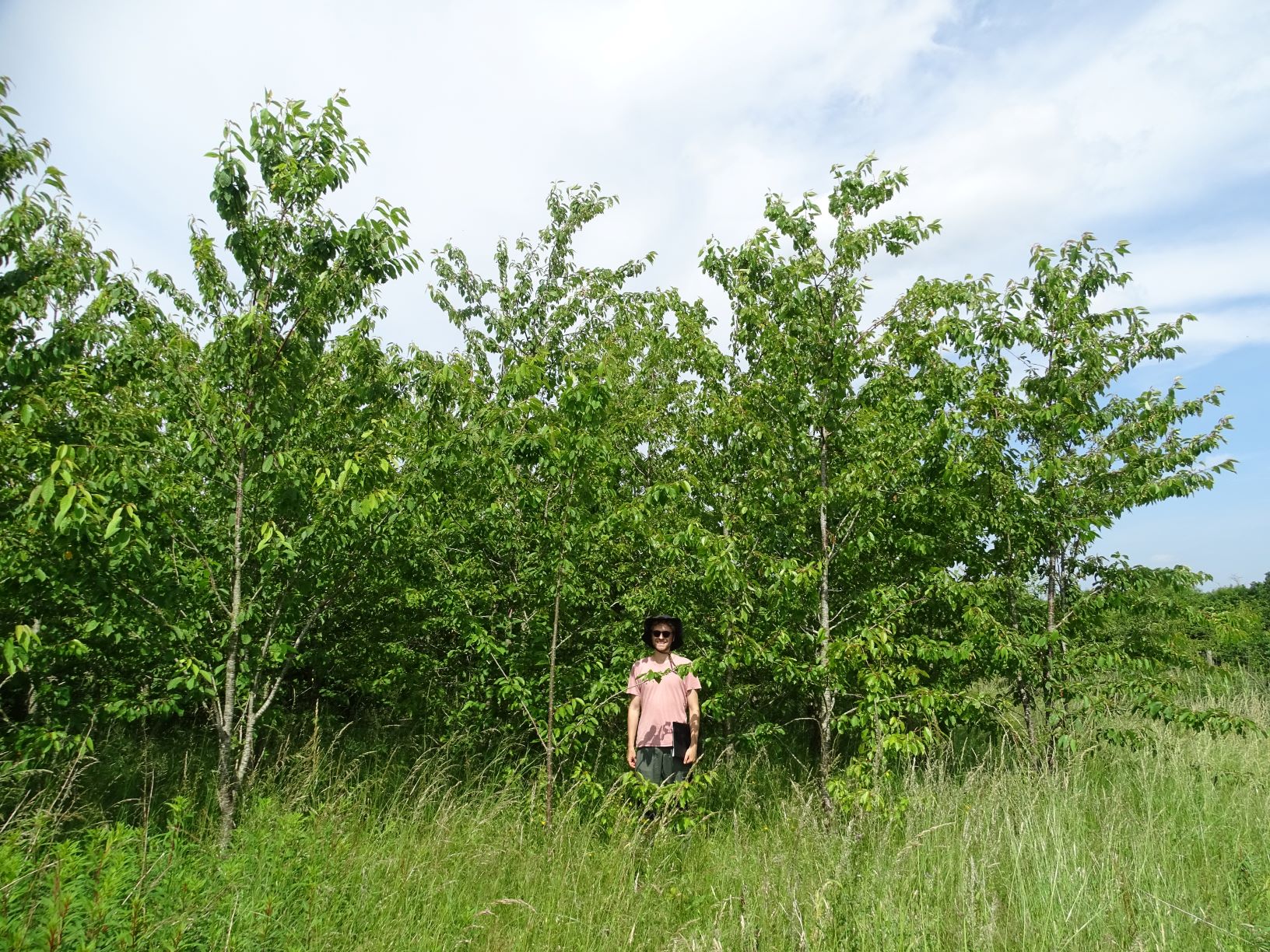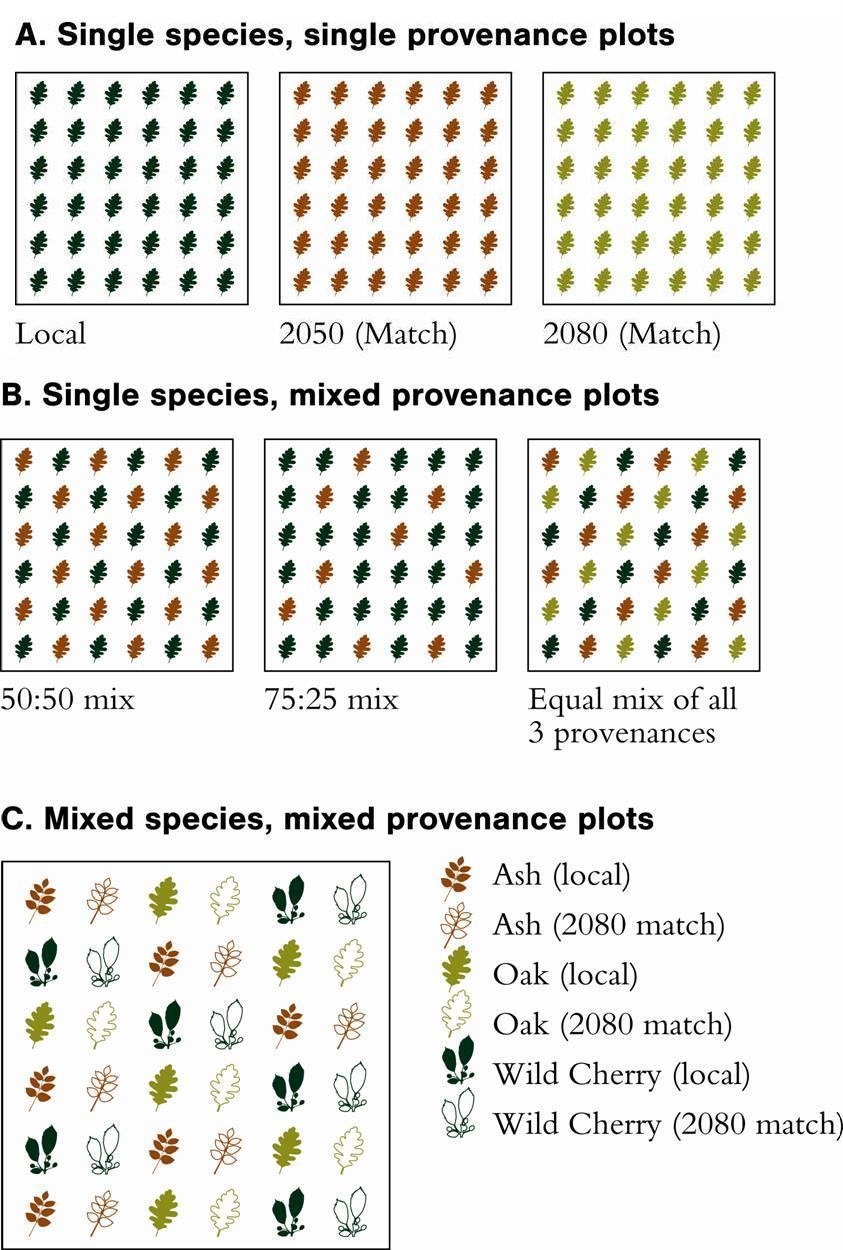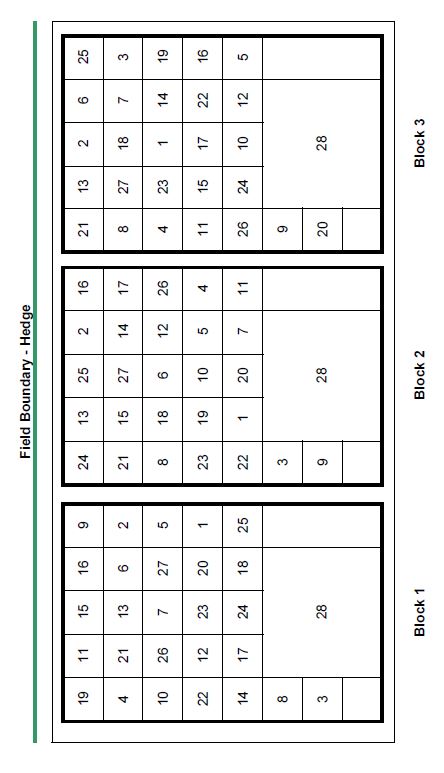Climate Match (UK)
At two sites plots have been planted, one in Derbyshire (central England) and the other in Kent (south-east England) in 2011. They serve as research-demonstration plots to test how various planting mixtures might contribute to improved resilience of native forests to climate change. Forest Research (UK) has matched the warmer, drier climate predicted for Derbyshire and Kent in 2050 with the present climate in northern France and the predicted climate for 2080 with that in northern Italy. Different ratios of local and non-local provenances are tested. The experiment will be monitored to identify the best mix of tree planting stock of each species for Derbyshire/Kent and how provenances from northern France and northern Italy interact with local wildlife, including their resilience to tree pests and diseases.

Design
The experiment is performed at two sites: Kent and Derbyshire. The only difference in design between the sites is the number of provenances planted: 3 in Kent, 4 in Derbyshire (the most northern plantation). Each site contains 3 blocks, i.e., replicates of the experiment setup. A block consists of 3 types of treatment plots: single-species single-provenance, single-species mixed-provenances, mixed-species mixed-provenances. In each block, the single-species plots occur as a series of randomly positioned plots (12 m x 12 m), in which 36 trees are planted. The single-species mixed-provenances plots consist of 2 provenances (50:50 or 75:25 mix, with the local provenance having the greatest proportion) or 3 provenances (33:33:33 mix). There is 1 mixed-species mixed-provenance plot (36 m x 32 m, 288 trees) in each block. The planting was done with 3 year old saplings, at a 2 m x 2 m planting distance.


Site characteristics
| Climate Match (Derbyshire) | Climate Match (Kent) | |
|---|---|---|
| Country | UK | UK |
| Local name | Hartshorne | Hucking Estate |
| Biome | temperate | temperate |
| Latitude | 52.794873 | 51.297229 |
| Longitude | -1.5164137 | 0.62998652 |
| Soil type | similar ratios of clay, silt and sand | plateau drift clay with flint, underlying geology of chalk |
| Former land use | arable | ungrazed pasture (grass and ragwort) |
| Altitude | 143 m | 170 m |
| Design | regular alternate | regular alternate |
| Plot shape | square | square |
| Plot size (m^2) | 1440 m² | 1441 m² |
| Plant distance (m) | 2 | 2 |
| Number of trees planted | A: 1512 trees B: 1728 trees C: 846 trees |
A: 1188 trees B: 1728 trees C: 846 trees |
| Planting date | February 2011 | March 2011 |
| Diversity variables | species richness genetic diversity |
species richness genetic diversity |
| Diversity gradient | 1, 4 sp. 1, 2, 3 provenances (local, Southern England, France, Italy) |
1, 4 sp. 1, 2, 3 provenances (local, France, Italy) |
| Size species pool | 4 | 4 |
| Species pool | Fraxinus excelsior Prunus avium Quercus robur Castanea sativa |
Fraxinus excelsior Prunus avium Quercus robur Castanea sativa |
| Contact person | Nadia Barsoum | Nadia Barsoum |
| nadia.barsoum@forestresearch.gov.uk | nadia.barsoum@forestresearch.gov.uk |
Research
Research questions that will be addressed include: (1) Which planting stock of oak, ash, wild cherry and sweet chestnut is recommended for woodland establishment in the Midlands and southeastern Britain in the face of climate change? (2) What is the recommended planting ratio of local and non-local provenances of these tree species to achieve maximum survival and growth rates? (3) How does mixing local and non-local provenances affect stand structure and provenance performance? (4) How do non-native provenances affect associated biodiversity and the incidence of pests and diseases?
The following specific assessments of saplings are being done or planned: survival (post-frost, post-drought), growth (height, dbh), form (leaf area, branching patterns), phenology (e.g., bud-burst), and associated biodiversity (e.g., incidence of insect herbivory). When a canopy starts to develop, litter traps will be installed to provide information on the comparative biomass of flowers, leaves, and fruits. Local variations in temperature are currently being monitored at the soil surface.
Extra information
Send an e-mail to the contact person, visit her web page, or explore the publications that utilized data from this experiment.
Research papers
- Blondeel H, Guillemot J, Martin‐StPaul N, Druel A, Bilodeau‐Gauthier S, Bauhus J, … Baeten L 2024 Tree diversity reduces variability in sapling survival under drought. Journal of Ecology 112(5): 1164-1180 - https://doi.org/10.1111/1365-2745.14294
- Vázquez-González C, Castagneyrol B, Muiruri EW, Barbaro L, Abdala-Roberts L, Barsoum N, Fründ J, Glynn C, Jactel H, McShea WJ, Mereu S, Mooney KA, Morillas L, Nock CA, Paquette A, Parker JD, Parker, WC, Roales J, Scherer-Lorenzen M, Schuldt A, Verheyen K, Weih M, Yang B, Koricheva J 2024 Tree diversity enhances predation by birds but not by arthropods across climate gradients. Ecology Letters (27): e14427 - https://doi.org/10.1111/ele.14427
- Zheng L, Barry KE, Guerrero-Ramírez NR, Craven D, Reich PB, Verheyen K, … Hautier Y 2024 Effects of plant diversity on productivity strengthen over time due to trait-dependent shifts in species overyielding. Nature communications 15(1): 2078 - https://doi.org/10.1038/s41467-024-46355-z
- Depauw L, De Lombaerde E, Dhiedt E, Blondeel H, Abdala-Roberts L, Auge H, Barsoum N, Bauhus J, Chu C, Damtew A, Eisenhauer N, V. Fagundes M, Ganade G, Gendreau-Berthiaume B, Godbold D, Gravel D, Guillemot J, Hajek P, Hector A, Hérault B, Jactel H, Koricheva J, Kreft H, Liu X, Mereu S, Messier C, Muys B, Nock CA, Paquette A, Parker JD, Parker WC, Paterno, GB, Perring MP, Ponette Q, Potvin C, Reich PB, Rewald B, Scherer-Lorenzen M, Schnabel F, Sousa-Silva R, Weih M, Clara Zemp D, Verheyen K, Baeten L 2024 Enhancing Tree Performance Through Species Mixing: Review of a Quarter-Century of TreeDivNet Experiments Reveals Research Gaps and Practical Insights. Current Forestry Reports - https://doi.org/10.1007/s40725-023-00208-y
- Desie E, Zuo J, Verheyen K, Djukic I, Van Meerbeek K, Auge H, Barsoum N, Baum C, Bruelheide H, Eisenhauer N, Feldhaar H, Ferlian O, Gravel D, Jactel H, Kappel Schmidt I, Kepfer-Rojas S, Meredieu C, Mereu S, Messier C, Morillas L, Nock C, Paquette A, Ponette Q, Reich PB, Roales J, Scherer-Lorenzen M, Seitz S, Schmidt A, Stefanski A, Trogisch S, van Halder I, Weih M, Williams LJ, Yang B, Muys B 2023 Disentangling drivers of litter decomposition in a multi-continent network of tree diversity experiments. Science of the Total Environment 857(3): 159717 - https://doi.org/10.1016/j.scitotenv.2022.159717
- FAO 2023 Towards more resilient and diverse planted forests. Unasylva (254)74: 2031/1. Rome. https://doi. org/10.4060/cc8584en
- Kwon T, Shibata H, Kepfer-Rojas S, Schmidt IK, Larsen KS, Beier C, Berg B, Verheyen K, Lamarque J-F, Hagedorn F, Eisenhauer N, Djukic I, TeaCompositionNetwork 2021 Effects of climate and atmospheric nitrogen deposition on early to mid-term stage litter decomposition across biomes. Frontiers in Forests and Global Change 4: 678480 - https://doi.org/10.3389/ffgc.2021.678480
- Messier C, Bauhus J, Sousa-Silva R, Auge H, Baeten L, Barsoum N, Bruelheide H, Caldwell B, Cavender-Bares J, Dhiedt E, Eisenhauer N, Ganade G, Gravel D, Guillemot J, Hall JS, Hector A, Hérault B, Jactel H, Koricheva J, Kreft H, Mereu S, Muys B, Nock CA, Paquette A, Parker JD, Perring MP, Ponette Q, Potvin C, Reich PB, Scherer-Lorenzen M, Schnabel F, Verheyen K, Weih M, Wollni M, Zemp DC 2021 For the sake of resilience and multifunctionality, let’s diversify planted forests! Conservation Letters e12829 - https://doi.org/10.1111/conl.12829
- Field E, Schönrogge K, Barsoum N, Hector A, Gibbs M 2019 Individual tree traits shape insect and disease damage on oak in a climate-matching tree diversity experiment. Ecology and Evolution 9: 15 - doi: 10.1002/ece3.5357
- Barsoum N 2015 Mixed provenance and mixed species trials aimed at informing the debate on how to prepare native tree species for climate change in England. Quarterly Journal of Forestry 109: 201-207
Acknowledgements
The Derbyshire site was established in partnership with the National Forest Company and the Forestry Commission. The Kent site is jointly sponsored by the Forestry Commission and the European Union within the framework of two Interreg projects: the Management of Multifunctional Forests project (MULTIFOR) and the Forest Management Adaptation project (ADAFOR). MULTIFOR (2009-2013) was funded under the European Interreg IV A 2 Mers Seas Zeeën Cross-Border Cooperation Programme; ADAFOR (2013-2015) was selected under the European cross-border cooperation programme INTERREG IV A France (Channel) - England, co-funded by the ERDF. Land for planting the Kent site was provided by the Woodland Trust.
The Kent experiment is jointly sponsored by the Forestry Commission and the European Union within the framework of the European Interreg IV A 2 Mers Seas Zeeën Cross-Border Cooperation Programme under the project MultiFor.
! Website of experiment does no longer exist


